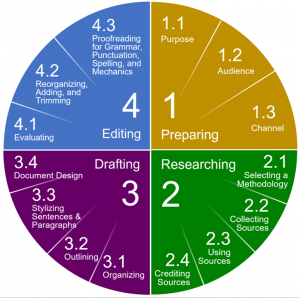Chapter 2: The Writing Process 1: Preparing
Learning Objectives
- Distinguish between general and specific purposes for writing.
- Analyze primary and secondary audiences using common profiling techniques
- Identify techniques for adjusting writing style according to audience size, position relative to you, knowledge of your topic, and demographic.
- Distinguish between communication channels to determine which is most appropriate for particular situations.
- Plan, write, revise, and edit short documents and messages that are organized, complete, and tailored to specific audiences.
- Identify your audience and purpose for writing
- Anticipate audience expectations
- Use pre-writing strategies to generate ideas, as well as select and limit a topic
- Write with an understanding of the audience, purpose, and appropriate format for the task
- Select appropriate channels for delivering messages
- Incorporate elements of business writing style
- : Select and use common, basic information technology tools to support communication.
- Identify common technology tools used to support communication
- Identify the strengths and drawbacks of various communication technologies
- Select the technology appropriate for the task
Like communication in general, good writing comes from following a process. Between an author hatching an idea and the audience reading and understanding that idea, the writing process enables the author to craft messages in a time-efficient manner that ultimately meets the needs of the audience. Without following a four-stage process from (1) preparing to (2) information gathering, to (3) drafting, to (4) editing through to sending the message, an author can waste plenty of their own time writing what doesn’t need to be written and wasting the reader’s time by confusing them with a message that doesn’t meet their needs. The next four chapters deal with each of these four writing stages, dividing them into several steps that, when followed as a matter of habit, can save you time by helping you write no more or less than you need to in achieving your professional communication goals.


Figure 2: The four-stage writing process and Stage 1 breakdown
- 2.1: Knowing Your Purpose for Writing
- 2.2: Analyzing Your Audience
- 2.3: Selecting Appropriate Channels

